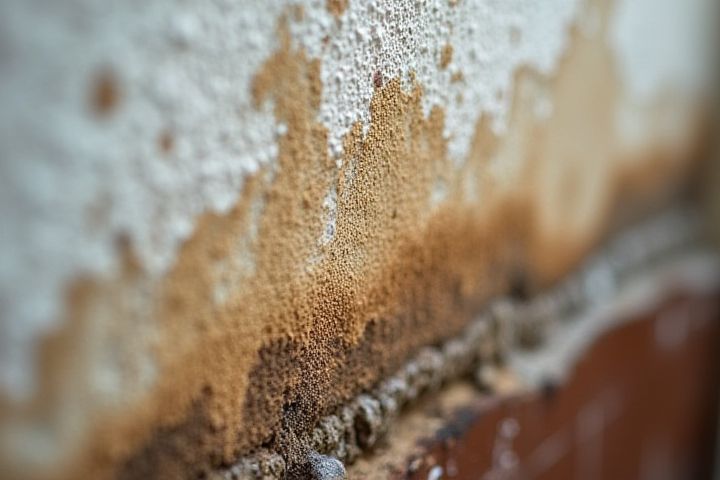
House dampness is primarily caused by excess moisture in the environment, which can arise from various sources. Common culprits include poor ventilation, leading to condensation, and leaks from plumbing or roofing that introduce unwanted water. Ground moisture can also permeate through foundations, especially if drainage systems are inadequate. You may notice mold growth, peeling paint, or musty odors as signs of dampness in your home. Addressing these issues promptly is essential to maintain indoor air quality and prevent structural damage.
What Causes House Dampness
Poor ventilation
Poor ventilation is a primary cause of house dampness, allowing moisture-laden air to circulate and settle on surfaces. Inadequate airflow can lead to high humidity levels, often exceeding 60%, which creates an ideal environment for mold and mildew growth. Stagnant air traps moisture from everyday activities, like cooking and showering, contributing to condensation on windows and walls. You can mitigate this issue by ensuring proper airflow through exhaust fans, open windows, and air circulation systems, effectively reducing dampness and promoting a healthier indoor environment.
Inadequate insulation
Inadequate insulation in your home can lead to significant house dampness, primarily by allowing warm, moist air to escape or enter unregulated. When the insulation fails to maintain consistent temperatures, condensation occurs on cold surfaces, such as walls and windows. This excess moisture creates an ideal environment for mold and mildew growth, exacerbating health issues and damaging building materials. Studies indicate that homes lacking proper insulation can experience up to 40% higher humidity levels, contributing to structural problems and increased heating costs.
Leaky roofs
Leaky roofs are a significant contributor to house dampness, allowing rainwater or melted snow to penetrate the interior spaces. Over time, the moisture from leaks can lead to structural damage, mold growth, and a musty odor, compromising indoor air quality. Common causes of roof leaks include damaged shingles, corroded flashing, and improperly sealed roof vents. Addressing these issues promptly can help prevent further deterioration and maintain a dry, healthy living environment in your home.
Blocked gutters
Blocked gutters can lead to significant house dampness by preventing rainwater from draining properly away from your home. When gutters overflow, water can seep into your walls, foundation, and even your basement, creating a perfect environment for mold and mildew growth. This issue is particularly pronounced in regions with heavy rainfall, where accumulated water can saturate building materials, ultimately compromising structural integrity. Regularly cleaning your gutters--ideally at least twice a year--can help prevent these costly damp-related problems and ensure your home remains dry and healthy.
Rising damp
Rising damp occurs when moisture from the ground ascends through the walls of a building, typically due to capillary action in porous materials like brick or stone. This process is often exacerbated by the presence of inadequate damp-proofing measures, which can allow water to rise up to 1 meter or more. In older properties, the absence of a damp-proof course, a barrier usually made of mortar or plastic, significantly increases the risk of rising damp. It can lead to structural issues, mold growth, and health problems, making it crucial for homeowners to address and mitigate this issue promptly.
Condensation
Condensation is a primary cause of house dampness, occurring when warm, moist air comes into contact with cooler surfaces, leading to the transformation of vapor into liquid. In households, areas like bathrooms, kitchens, and poorly ventilated rooms are especially prone to this phenomenon, often resulting in water droplets forming on walls, windows, and ceilings. Factors such as high indoor humidity levels, inadequate ventilation, and thermal bridging from poorly insulated walls can exacerbate condensation issues. Maintaining humidity levels below 60% and ensuring proper airflow are crucial steps in preventing condensation-related dampness in your home.
Plumbing leaks
Plumbing leaks are a significant cause of house dampness, leading to moisture accumulation in walls, floors, and ceilings. Even a small leak can introduce up to 10,000 gallons of water into your home annually, creating an ideal environment for mold growth and structural damage. Common sources of these leaks include burst pipes, faulty fixtures, and aging plumbing systems, often exacerbated by pressure fluctuations. You should regularly inspect your plumbing for signs of leaks, such as water stains or damp spots, to prevent extensive damage and ensure a dry, healthy living space.
Flooding
Flooding is a significant contributor to house dampness, often resulting from heavy rainfall, melting snow, or overflowing rivers. When water infiltrates your property, it can saturate walls, floors, and foundations, leading to persistent moisture levels that encourage mold growth and structural damage. In the U.S., over 90% of basement flooding incidents are linked to inadequate drainage systems, which can exacerbate damp conditions. It's crucial to address drainage solutions and waterproofing methods to protect your home from the long-term effects of flooding-related dampness.
High humidity levels
High humidity levels are a primary cause of house dampness, often resulting from inadequate ventilation, poor insulation, or excessive moisture-generating activities, such as cooking and bathing. When indoor humidity exceeds 60%, it creates an environment conducive to mold growth and condensation on surfaces like windows and walls. Your living space can suffer structural damage due to the persistent moisture, leading to peeling paint, wallpaper damage, and wood rot. To mitigate these issues, using dehumidifiers, ensuring proper airflow, and maintaining temperature control can significantly reduce humidity levels and improve overall indoor air quality.
Groundwater seepage
Groundwater seepage is a primary cause of house dampness, occurring when moisture from the soil infiltrates building structures through cracks or porous materials. This phenomenon often leads to increased humidity levels, which can result in mold growth and structural damage, impacting 30% of homes in affected areas. The water table's fluctuating levels, particularly during heavy rainfall or rapid snowmelt, exacerbate this issue, making homes vulnerable to dampness year-round. Identifying and addressing groundwater seepage early can save homeowners 15% on repair costs and improve indoor air quality significantly.
